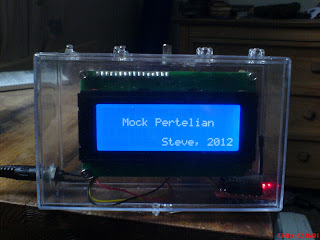The last post concluded with a shopping list of requirements for a workable wireless display. The picture above shows a prototype of such a thing. In particular:
- It doesn't try to be too clever: it uses an XBee as a wireless serial port and lets an ATMega do the heavy lifting, driving the display in 8-bit mode.
- It is compatible with an existing lcdproc driver, pertelian, hence the name.
- It bites the bullet and uses an external supply rather than batteries.
The circuit diagram and Arduino sketch are shown below.
Update: after running for a week or so at 9600 baud, the 20x4 display was messed up. Although I never got to the bottom of it, the fault lay in the transmitting XBee: unless it was power-cycled, the problem persisted through reboots of the display and the box running LCDd. A successful workaround was to run all parts of the system at 57600 baud, i.e., both serial ports and both XBees.

